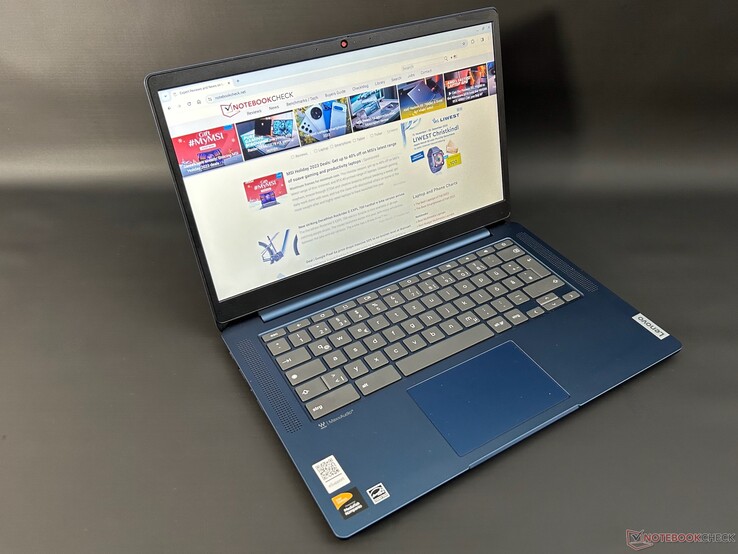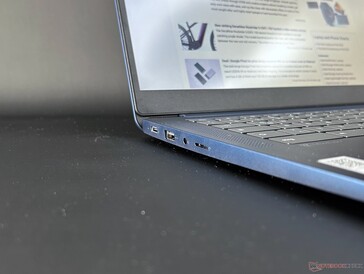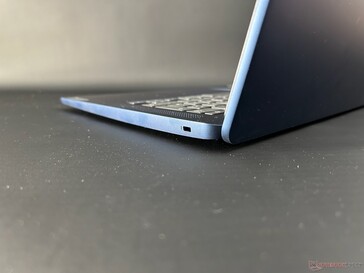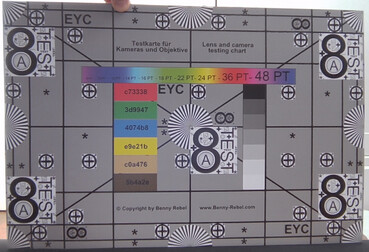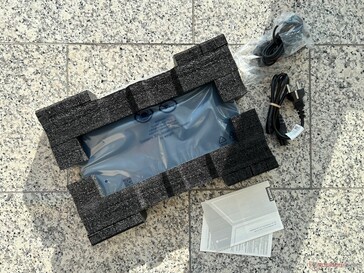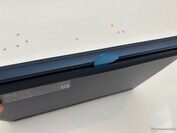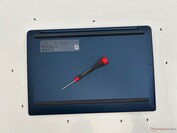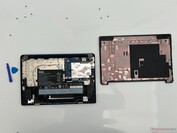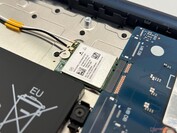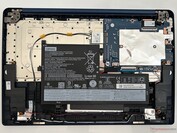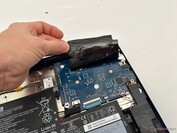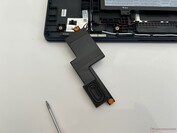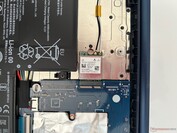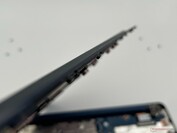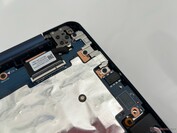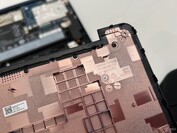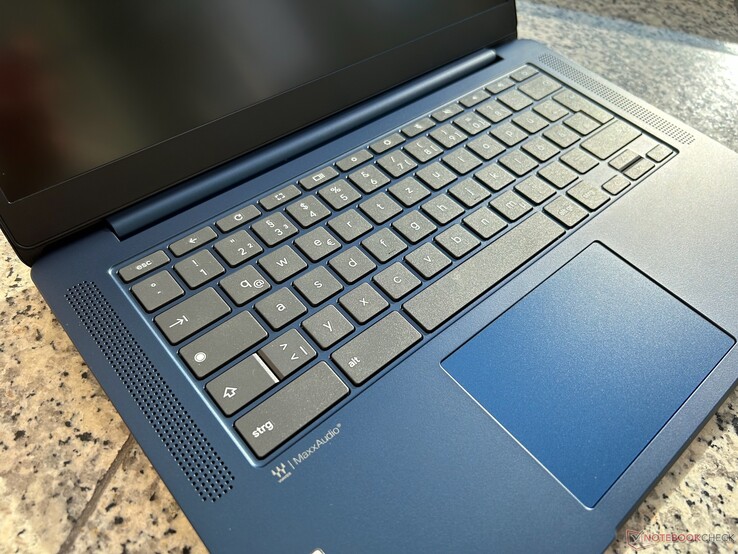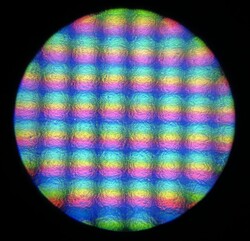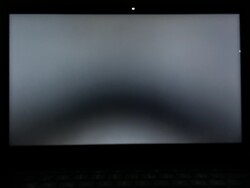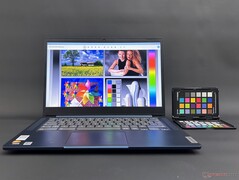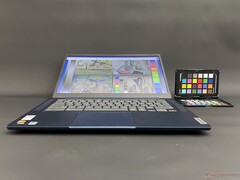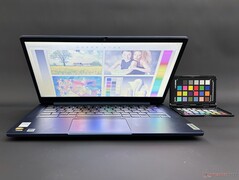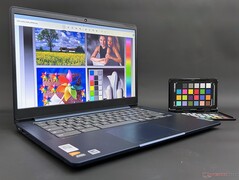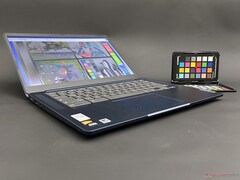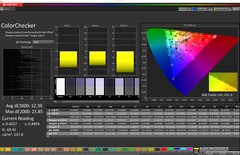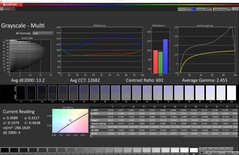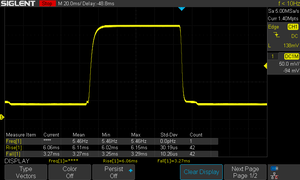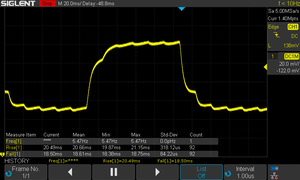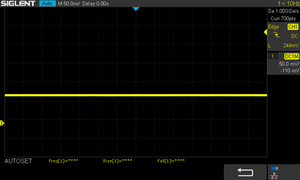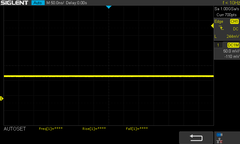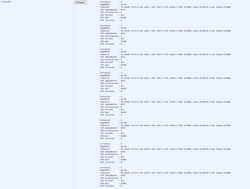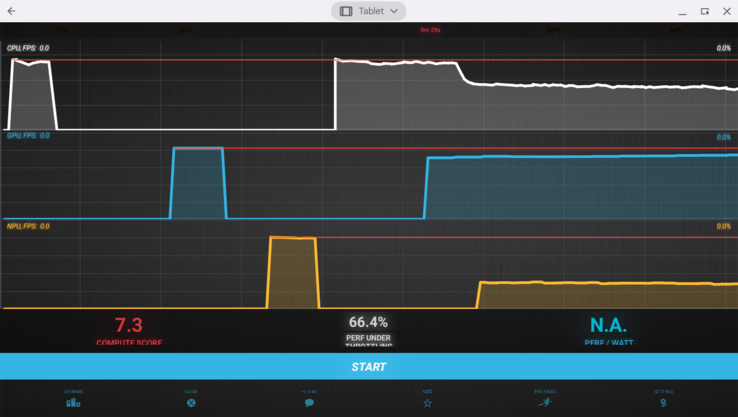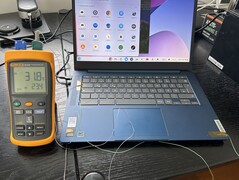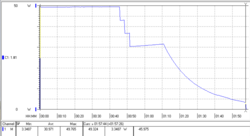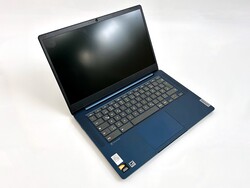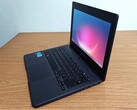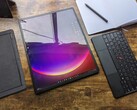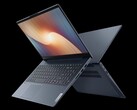Lenovo IdeaPad Slim 3 CB 14M868 review - The MediaTek Kompanio 520 introductory Chromebook
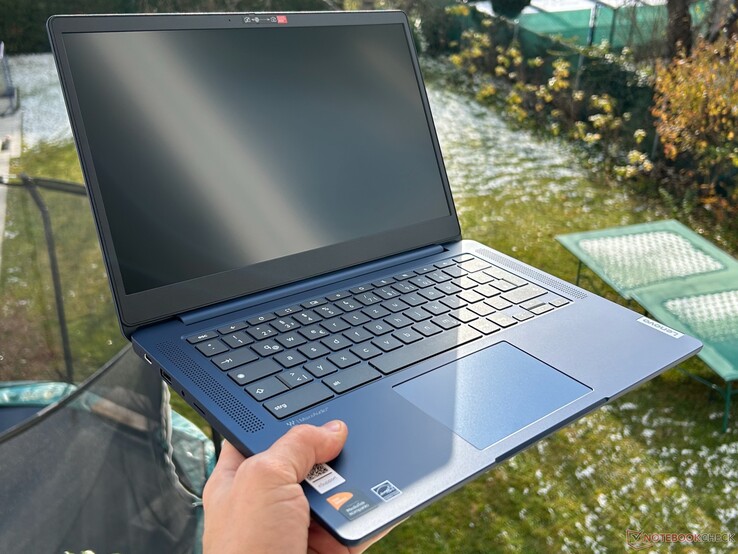
We purchased our new test device during Black Friday on Amazon for an unbelievable US$110. Currently, the laptop's prices range from US$200 to US$230 and it was the cheapest laptop of December 2023. In order to reach this low price, Lenovo has, as expected, had to make quite a few savings. Inside the Chromebook, you can find hardware usually known from smartphones, namely a MediaTek-ARM SoC, 4 GB RAM and 64 GB of slow eMMC flash storage. Thanks to its frugal ChromeOS, the hardware doesn't have to be a dealbreaker.
Optionally, you can also get the Lenovo IdeaPad Slim 3 Chromebook (14" MediaTek) with 128 GB eMMC and an IPS touchscreen. The IPS panel's better viewing angles may prove to be a particularly big reason to upgrade from our test device's TN touchscreen. However, in the region in which this laptop was tested (DACH region), this isn't currently available. Instead, you can only find an Alder Lake-N-based model 14IAN8 with a Core i3-N305, 8 GB RAM and 256 GB flash storage. At over US$700, this is a whole other price range. Thankfully, you can find the model with an IPS panel in the United States. Here, this version retails for about US$270.
In the support area, Lenovo has also listed this device as the "IP Slim 3 Chrome 14M868 - Type 82XJ".
Possible competitors compared
Rating | Date | Model | Weight | Height | Size | Resolution | Price |
|---|---|---|---|---|---|---|---|
| 78.5 % v7 (old) | 01 / 2024 | Lenovo IdeaPad Slim 3 CB 14M868 Kompanio 520, Mali-G52 MP2 | 1.3 kg | 19.3 mm | 14.00" | 1920x1080 | |
| 79.9 % v7 (old) | 04 / 2022 | Asus Chromebook Flip CM1 3015Ce, Vega 3 | 1.7 kg | 18.6 mm | 14.00" | 1920x1080 | |
| 77.2 % v7 (old) | 08 / 2023 | HP Chromebook 15a-n0008TU Celeron N4500, UHD Graphics (Jasper Lake 16 EU) | 1.7 kg | 18.1 mm | 15.60" | 1366x768 | |
| 78.1 % v7 (old) | 07 / 2020 | Lenovo IdeaPad Flex 3 11IGL05 Celeron N4020, UHD Graphics 600 | 1.1 kg | 17.5 mm | 11.60" | 1366x768 | |
| 78.1 % v7 (old) | 01 / 2024 | Asus Chromebook CM14 CM1402CM2A-EK0048 Kompanio 520, Mali-G52 MP2 | 1.4 kg | 22 mm | 14.00" | 1920x1080 | |
| 79.3 % v7 (old) | 08 / 2021 | Samsung Galaxy Book Go SD 7c Gen 2, Adreno 618 | 1.4 kg | 15 mm | 14.00" | 1920x1080 | |
| 79.4 % v7 (old) | 01 / 2022 | Lenovo IdeaPad Duet 5 Chromebook SD 7c, Adreno 618 | 715 g | 7.2 mm | 13.30" | 1920x1080 | |
| 77.6 % v7 (old) | 12 / 2021 | Acer Aspire 1 A114-61-S58J SD 7c, Adreno 618 | 1.5 kg | 18.9 mm | 14.00" | 1920x1080 | |
| 79.8 % v7 (old) | 09 / 2020 | Lenovo IdeaPad Duet Chromebook 10 CT-X636F Helio P60T, Mali-G72 MP3 | 920 g | 18.2 mm | 10.10" | 1920x1200 |
Case
Visually, the MediaTek Chromebook's plastic case feels better quality than its price would make you think. As it is also used for much more expensive devices, you will greatly benefit from this. The design is clearly inspired by Apple's MacBook Air and looks great thanks to its sleek shape. Because of its tapered edges, the case appears slimmer than it actually is. Unfortunately, the plastic used for this device is quite prone to attracting scratches. Despite being very careful, we already noticed a few visible scratches on the top part of our test device's case. Compared to Apple's aluminum cases, the IdeaPad may not be able to keep up in terms of haptics or stability, but especially when taking into account its low price, we are very happy with our test sample's case. One small weakness is that you can hear a clicking noise when picking the laptop up by one of its corners, as well as when using the touchpad (although it doesn't seem to make use of an actual button click). Moreover, our test device doesn't sit totally evenly on its two feet.
Compared to its visual inspiration, the Apple MacBook Air, the IdeaPad Slim 3 is considerably thicker and its dimensions sit between the 13 and 15 inch models. In comparison to the similarly inexpensive Asus Chromebook CM14, the IP Slim 3 is a little smaller.
Connectivity
Apart from a Kensington port on the right side of the device, all its other ports are situated on the left—practical for right-handed people. The USB-C port is also used to supply the laptop with power, meaning you may be reliant on a docking station at times to use it. However, like the other USB-A port, the Chromebook only supports USB 3.2 Gen 1 (previously USB 3.0 and therefore 5 Gbps = 400 MB/s). With its headset port and microSD slot, you are actually only missing an HDMI port. As the MediaTek chip's video output is limited to Full HD, the same restrictions apply to external monitors, should you wish to connect one.
SD card reader
The installed microSD card reader achieved below-average results in our benchmarks. Compared to Asus' introductory model, Lenovo has pulled the short straw—however, its performance is fine for occasionally transferring photos and files. When used as a fixed storage medium, its data rates are quite limiting.
| SD Card Reader - average JPG Copy Test (av. of 3 runs) | |
| Lenovo IdeaPad Flex 3 11IGL05 (Toshiba Exceria Pro SDXC 64 GB UHS-II) | |
| HP Chromebook 15a-n0008TU (AV Pro SD microSD 128 GB V60) | |
| Asus Chromebook CM14 CM1402CM2A-EK0048 (AV Pro SD microSD 128 GB V60) | |
| Average of class Office (22.4 - 198.5, n=28, last 2 years) | |
| Lenovo IdeaPad Slim 3 CB 14M868 | |
| Asus Chromebook Flip CM1 (AV Pro SD microSD 128 GB V60) | |
| Cross Platform Disk Test (CPDT) | |
| SDCard Sequential Read 0.5 GB | |
| Lenovo IdeaPad Slim 3 CB 14M868 | |
| Lenovo IdeaPad Slim 3 CB 14M868 | |
| Lenovo IdeaPad Slim 3 CB 14M868 | |
| SDCard Sequential Write 0.5 GB | |
| Lenovo IdeaPad Slim 3 CB 14M868 | |
| Lenovo IdeaPad Slim 3 CB 14M868 | |
| Lenovo IdeaPad Slim 3 CB 14M868 | |
| SDCard Random Read 4KB 0.5 GB | |
| Lenovo IdeaPad Slim 3 CB 14M868 | |
| Lenovo IdeaPad Slim 3 CB 14M868 | |
| Lenovo IdeaPad Slim 3 CB 14M868 | |
| SDCard Random Write 4KB 0.5 GB | |
| Lenovo IdeaPad Slim 3 CB 14M868 | |
| Lenovo IdeaPad Slim 3 CB 14M868 | |
| Lenovo IdeaPad Slim 3 CB 14M868 | |
CPDT SD-Card Sequential Read / Write
Communication
The integrated WiFi 6 modem (plugged-in M.2 2230 2x2 module Lenovo 5W11H85391) worked perfectly in our test, but it also didn't achieve any record speeds.
Webcam
The installed webcam takes medium-quality images at 1280 x 960 pixels using ChromeOS. If there is enough light, the camera is good enough for video conferences. The mechanical cover situated above the webcam allows you to manually block the lens.
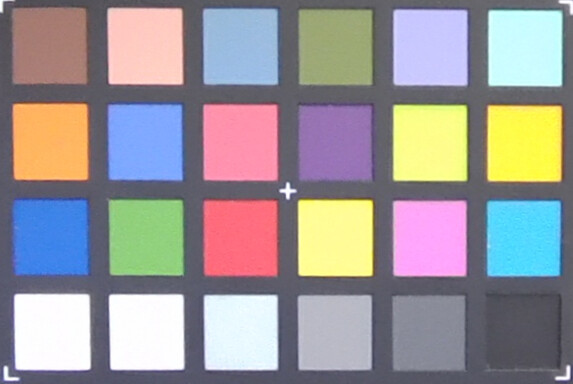
Accessories
Maintenance
Warranty
The IP Slim 3 Chrome 14M868 is covered by Lenovo's limited warranty. This can be looked up for individual products using their serial numbers via Lenovo's website. Warranty upgrades are available.
Input devices
Keyboard - Chiclet with a typical ChromeOS layout
The IdeaPad's keyboard features the standard layout for ChromeOS laptops. The individual chiclet keys are 15.5 x 15.2 mm in size and offer a sufficient lift of 1.4 mm. If you aren't used to a Chromebook, then you might have to get used to the short distance separating the Enter and "#" keys. Apart from this, the layout is comfortable. Haptically, the individual keys feel a little cheap and tend to rattle a bit. The author of this article managed to type fast on this keyboard (92 words per minute) and without any mistakes.
The keys feature white labelling which can be read easily, but they aren't backlit.
Touchpad - quite large
The installed clickpad is quite big (12 cm diagonally) and despite its plastic surface, it feels nice and smooth. Furthermore, the touchpad can be pressed down by 0.7 mm on the bottom 4/5 of its surface, which results in a satisfying and visually-noticeable click effect.
Display - can only boast good resolution
Within the introductory model, the display's only redeeming quality is its resolution. Its 1920 x 1080 pixels offer nice sharpness, in particular because ChromeOS can scale the user interface well and depicts text nicely. Its maximum brightness of 281 cd/m² in the middle of the screen is bright enough for indoor use, but even its matte display surface isn't much help in the sun. Plus, it isn't lit the most evenly; the bottom third was a little darker than the rest. Its black value is okay, resulting in a contrast ratio of 624:1. In terms of color depiction, the AUO 208D panel didn't achieve the best values. Its color deviations of 12.4 (average DeltaE) leave a lot to be desired. Another big disadvantage of the TN panel is its poor viewing-angle stability. Even when you move your head a small amount, you notice the screen's brightness varying. As a result, our photo of the laptop's viewing angles shows a pattern on the display. We were happy to note that Lenovo doesn't use PWM to dim the screen. Unfortunately, it seems that the panel is a cheap 6-bit panel, as we noted some Temporal Dithering when it came to gray values in our slow-motion video.
| |||||||||||||||||||||||||
Brightness Distribution: 85 %
Center on Battery: 281 cd/m²
Contrast: 624:1 (Black: 0.45 cd/m²)
ΔE ColorChecker Calman: 12.4 | ∀{0.5-29.43 Ø4.78}
ΔE Greyscale Calman: 13.2 | ∀{0.09-98 Ø5}
37.54% AdobeRGB 1998 (Argyll 3D)
54.35% sRGB (Argyll 3D)
| Lenovo IdeaPad Slim 3 CB 14M868 AUO 208D, TN, 1920x1080, 14" | Asus Chromebook CM14 CM1402CM2A-EK0048 CMN 14E5, TN, 1920x1080, 14" | Asus Chromebook Flip CM1 IPS, 1920x1080, 14" | Samsung Galaxy Book Go AUO203D, TN, 1920x1080, 14" | Lenovo IdeaPad Duet 5 Chromebook OLED, 1920x1080, 13.3" | Acer Aspire 1 A114-61-S58J Chi Mei N140HCA-EAC, IPS, 1920x1080, 14" | |
|---|---|---|---|---|---|---|
| Display | 16% | |||||
| Display P3 Coverage (%) | 42 | |||||
| sRGB Coverage (%) | 54.35 | 63 16% | ||||
| AdobeRGB 1998 Coverage (%) | 37.54 | 43.4 16% | ||||
| Response Times | -66% | -95% | -10% | 83% | -65% | |
| Response Time Grey 50% / Grey 80% * (ms) | 39.3 ? | 37 ? 6% | 40 ? -2% | 40 ? -2% | 2.3 ? 94% | 33 ? 16% |
| Response Time Black / White * (ms) | 9.4 ? | 22.4 ? -138% | 27 ? -187% | 11 ? -17% | 2.6 ? 72% | 23 ? -145% |
| PWM Frequency (Hz) | 24800 ? | 200 ? | 200 ? | 60.2 ? | 25000 ? | |
| Screen | 1% | 27% | -6% | 55% | 20% | |
| Brightness middle (cd/m²) | 281 | 230 -18% | 200 -29% | 230 -18% | 358 27% | 246 -12% |
| Brightness (cd/m²) | 259 | 204 -21% | 196 -24% | 201 -22% | 366 41% | 220 -15% |
| Brightness Distribution (%) | 85 | 81 -5% | 84 -1% | 80 -6% | 97 14% | 83 -2% |
| Black Level * (cd/m²) | 0.45 | 0.433 4% | 0.2 56% | 0.36 20% | 0.33 27% | |
| Contrast (:1) | 624 | 531 -15% | 1000 60% | 639 2% | 745 19% | |
| Colorchecker dE 2000 * | 12.4 | 8.91 28% | 4.82 61% | 12.23 1% | 1.93 84% | 5.31 57% |
| Colorchecker dE 2000 max. * | 21.9 | 19.81 10% | 20.61 6% | 23.26 -6% | 4.78 78% | 18.2 17% |
| Greyscale dE 2000 * | 13.2 | 10.3 22% | 1.64 88% | 15.28 -16% | 1.6 88% | 3.94 70% |
| Gamma | 2.239 98% | 2.43 91% | 2.55 86% | 2.22 99% | 2.21 100% | |
| CCT | 11724 55% | 6475 100% | 18403 35% | 6238 104% | 6356 102% | |
| Total Average (Program / Settings) | -33% /
-13% | -34% /
3% | -8% /
-6% | 69% /
62% | -10% /
5% |
* ... smaller is better
Display Response Times
| ↔ Response Time Black to White | ||
|---|---|---|
| 9.4 ms ... rise ↗ and fall ↘ combined | ↗ 6.1 ms rise | |
| ↘ 3.3 ms fall | ||
| The screen shows fast response rates in our tests and should be suited for gaming. In comparison, all tested devices range from 0.1 (minimum) to 240 (maximum) ms. » 25 % of all devices are better. This means that the measured response time is better than the average of all tested devices (20.2 ms). | ||
| ↔ Response Time 50% Grey to 80% Grey | ||
| 39.3 ms ... rise ↗ and fall ↘ combined | ↗ 20.7 ms rise | |
| ↘ 18.6 ms fall | ||
| The screen shows slow response rates in our tests and will be unsatisfactory for gamers. In comparison, all tested devices range from 0.165 (minimum) to 636 (maximum) ms. » 59 % of all devices are better. This means that the measured response time is worse than the average of all tested devices (31.6 ms). | ||
Screen Flickering / PWM (Pulse-Width Modulation)
| Screen flickering / PWM not detected | |||
In comparison: 53 % of all tested devices do not use PWM to dim the display. If PWM was detected, an average of 8111 (minimum: 5 - maximum: 343500) Hz was measured. | |||
Performance - SoC only for those with low demands
Testing conditions
As is usual for ChromeOS, there are no options to control the CPU/GPU performance. Details about the SoC are also barely available. As Android and Linux run using a virtual machine, these also don't make many details available.
Processor - small, old ARM cores
The processor part within the MediaTek Kompanio 520 consists of two clusters and a total of eight ARM-based CPU cores. The performance cluster houses two bigger ARM Cortex-A76 cores known from older smartphone processors such as the Qualcomm Snapdragon 855. There are six small ARM Cortex-A55 cores within the efficiency cluster. All cores have a maximum clock rate of 2 GHz.
When it comes to CPU performance, the small ARM cores can only keep up with the old Intel Pentium N5030 (Gemini Lake Quad-Core at max 3.1 GHz). The new Alder Lake N processors, such as the Intel N100, are considerably faster. Our comparisons were unfortunately restricted to the old Geekbench 5.5, as the newer 6.2 resulted in reproducible crashes.
| CPU Performance rating | |
| Average of class Office -1! | |
| Lenovo IdeaPad Slim 3 CB 14M868 | |
| Average MediaTek Kompanio 520 | |
| Geekbench 5.5 / Multi-Core | |
| Average of class Office (1719 - 16999, n=78, last 2 years) | |
| Lenovo IdeaPad Slim 3 CB 14M868 | |
| Average MediaTek Kompanio 520 (n=1) | |
| Geekbench 5.5 / Single-Core | |
| Average of class Office (811 - 2128, n=78, last 2 years) | |
| Lenovo IdeaPad Slim 3 CB 14M868 | |
| Average MediaTek Kompanio 520 (n=1) | |
| Geekbench ML / 0.6 TensorFlow Lite CPU | |
| Lenovo IdeaPad Slim 3 CB 14M868 | |
| Average MediaTek Kompanio 520 (n=1) | |
System performance - Introductory-level
The MediaTek system's system performance is also limited to absolute introductory levels. The Kompanio 520's total CrossMark score could only keep up with the slow Celeron J4125, remaining far behind newer CPUs. The Celeron N4020, often used in older introductory-level laptops, was left in the dust. Its CrXPRT 2 performance paints a similar picture. The Kompanio came just behind a Celeron N4500, but ahead of an AMD 3015Ce.
These weak benchmark results can also be felt in everyday use. Loading websites is a bit laggy and pages load quite a bit slower than on faster systems. In addition, watching YouTube videos at over 1080p leads to dropped frames and lagging playback. However, as the Chromebook doesn't support output at over 1080p, this negative point shouldn't be too important.
WebXPRT 4: Overall
Mozilla Kraken 1.1: Total
CrXPRT 2: Score | Photo Effects | Face Detection | Offline Notes | Stocks Dashboard | DNA Sequence Analysis | 3D Shapes
Cross Platform Disk Test (CPDT): Memory Copy 4MB
| CrossMark / Overall | |
| Average of class Office (381 - 2010, n=78, last 2 years) | |
| Lenovo Tab P11 Pro Gen 2 | |
| Lenovo IdeaPad Slim 3 CB 14M868 | |
| Average MediaTek Kompanio 520, ARM Mali-G52 MP2 (348 - 357, n=2) | |
| Asus Chromebook CM14 CM1402CM2A-EK0048 | |
| Lenovo IdeaPad Duet Chromebook 10 CT-X636F | |
| CrossMark / Productivity | |
| Average of class Office (464 - 1880, n=78, last 2 years) | |
| Lenovo Tab P11 Pro Gen 2 | |
| Lenovo IdeaPad Slim 3 CB 14M868 | |
| Average MediaTek Kompanio 520, ARM Mali-G52 MP2 (393 - 400, n=2) | |
| Asus Chromebook CM14 CM1402CM2A-EK0048 | |
| Lenovo IdeaPad Duet Chromebook 10 CT-X636F | |
| CrossMark / Creativity | |
| Average of class Office (319 - 2361, n=78, last 2 years) | |
| Lenovo Tab P11 Pro Gen 2 | |
| Lenovo IdeaPad Slim 3 CB 14M868 | |
| Average MediaTek Kompanio 520, ARM Mali-G52 MP2 (340 - 350, n=2) | |
| Asus Chromebook CM14 CM1402CM2A-EK0048 | |
| Lenovo IdeaPad Duet Chromebook 10 CT-X636F | |
| CrossMark / Responsiveness | |
| Average of class Office (360 - 1781, n=78, last 2 years) | |
| Lenovo Tab P11 Pro Gen 2 | |
| Lenovo IdeaPad Slim 3 CB 14M868 | |
| Average MediaTek Kompanio 520, ARM Mali-G52 MP2 (258 - 268, n=2) | |
| Asus Chromebook CM14 CM1402CM2A-EK0048 | |
| Lenovo IdeaPad Duet Chromebook 10 CT-X636F | |
| WebXPRT 4 / Overall | |
| Average of class Office (104.2 - 328, n=81, last 2 years) | |
| HP Dragonfly Pro Chromebook | |
| HP Chromebook 15a-n0008TU | |
| Lenovo IdeaPad Slim 3 CB 14M868 | |
| Average MediaTek Kompanio 520, ARM Mali-G52 MP2 (80 - 81, n=2) | |
| Asus Chromebook CM14 CM1402CM2A-EK0048 | |
| Lenovo Tab P11 Pro Gen 2 | |
| Lenovo IdeaPad Duet Chromebook 10 CT-X636F | |
| Mozilla Kraken 1.1 / Total | |
| Lenovo IdeaPad Duet Chromebook 10 CT-X636F | |
| Asus Chromebook CM14 CM1402CM2A-EK0048 | |
| Average MediaTek Kompanio 520, ARM Mali-G52 MP2 (1814 - 1966, n=2) | |
| Samsung Galaxy Book Go | |
| Lenovo IdeaPad Slim 3 CB 14M868 | |
| Acer Aspire 1 A114-61-S58J | |
| Lenovo IdeaPad Duet 5 Chromebook | |
| HP Chromebook 15a-n0008TU | |
| Lenovo Tab P11 Pro Gen 2 | |
| Asus Chromebook Flip CM1 | |
| Average of class Office (391 - 1297, n=80, last 2 years) | |
| HP Dragonfly Pro Chromebook | |
| CrXPRT 2 / Score | |
| Average of class Office (n=1last 2 years) | |
| HP Dragonfly Pro Chromebook | |
| HP Chromebook 15a-n0008TU | |
| Lenovo IdeaPad Slim 3 CB 14M868 | |
| Average MediaTek Kompanio 520, ARM Mali-G52 MP2 (n=1) | |
| Asus Chromebook Flip CM1 | |
| Lenovo IdeaPad Duet Chromebook 10 CT-X636F | |
| CrXPRT 2 / Photo Effects | |
| Lenovo IdeaPad Duet Chromebook 10 CT-X636F | |
| Lenovo IdeaPad Slim 3 CB 14M868 | |
| Average MediaTek Kompanio 520, ARM Mali-G52 MP2 (n=1) | |
| Asus Chromebook Flip CM1 | |
| HP Dragonfly Pro Chromebook | |
| Average of class Office (n=1last 2 years) | |
| CrXPRT 2 / Face Detection | |
| Lenovo IdeaPad Duet Chromebook 10 CT-X636F | |
| Asus Chromebook Flip CM1 | |
| Lenovo IdeaPad Slim 3 CB 14M868 | |
| Average MediaTek Kompanio 520, ARM Mali-G52 MP2 (n=1) | |
| HP Dragonfly Pro Chromebook | |
| Average of class Office (n=1last 2 years) | |
| CrXPRT 2 / Offline Notes | |
| Lenovo IdeaPad Duet Chromebook 10 CT-X636F | |
| Asus Chromebook Flip CM1 | |
| Lenovo IdeaPad Slim 3 CB 14M868 | |
| Average MediaTek Kompanio 520, ARM Mali-G52 MP2 (n=1) | |
| Average of class Office (n=1last 2 years) | |
| HP Dragonfly Pro Chromebook | |
| CrXPRT 2 / Stocks Dashboard | |
| Lenovo IdeaPad Duet Chromebook 10 CT-X636F | |
| Asus Chromebook Flip CM1 | |
| Lenovo IdeaPad Slim 3 CB 14M868 | |
| Average MediaTek Kompanio 520, ARM Mali-G52 MP2 (n=1) | |
| HP Dragonfly Pro Chromebook | |
| Average of class Office (n=1last 2 years) | |
| CrXPRT 2 / DNA Sequence Analysis | |
| Lenovo IdeaPad Duet Chromebook 10 CT-X636F | |
| Lenovo IdeaPad Slim 3 CB 14M868 | |
| Average MediaTek Kompanio 520, ARM Mali-G52 MP2 (n=1) | |
| Asus Chromebook Flip CM1 | |
| Average of class Office (n=1last 2 years) | |
| HP Dragonfly Pro Chromebook | |
| CrXPRT 2 / 3D Shapes | |
| Lenovo IdeaPad Duet Chromebook 10 CT-X636F | |
| Asus Chromebook Flip CM1 | |
| Lenovo IdeaPad Slim 3 CB 14M868 | |
| Average MediaTek Kompanio 520, ARM Mali-G52 MP2 (n=1) | |
| HP Dragonfly Pro Chromebook | |
| Average of class Office (n=1last 2 years) | |
| Cross Platform Disk Test (CPDT) / Memory Copy 4MB | |
| Lenovo IdeaPad Slim 3 CB 14M868 | |
| Average MediaTek Kompanio 520, ARM Mali-G52 MP2 (n=1) | |
| Lenovo IdeaPad Duet Chromebook 10 CT-X636F | |
| Lenovo IdeaPad Duet Chromebook 10 CT-X636F | |
| HP Chromebook 15a-n0008TU | |
| Average of class Office (n=1last 2 years) | |
* ... smaller is better
Storage devices - Slow eMMC chip
As a storage device, the Lenovo Chromebook relies on slow eMMC 5.1 chips that are soldered on. The introductory model has 64 GB, of which only 46 GB are free to use. A further 10 GB will be needed for Crostini, which really doesn't leave much space for Android and Linux apps or for your own photos and videos.
| Drive Performance rating - Percent | |
| Average of class Office | |
| Average 64 GB eMMC Flash | |
| Lenovo IdeaPad Duet Chromebook 10 CT-X636F | |
| HP Chromebook 15a-n0008TU | |
| Lenovo IdeaPad Slim 3 CB 14M868 | |
CPDT eMMC Sequential Read / Write
Graphics card - Mali GPU from smartphones
The MediaTek Kompanio 520's graphics card is the small ARM Mali-G52MP2 iGPU. Users have access to only two of its possible six cores and this iGPU is often used in older smartphone SoCs. Its performance (e.g. in GFXBench Aztec ruins Normal Offscreen) is comparable to the smartphone variants and has a similar speed to a UHD Graphics 600 inside the Celeron N4000 (e.g. Lenovo Chromebook S340). During the DMark Wild Life stress test, we didn't see any signs that the GPU was throttled. On the other hand, the Stress Test app revealed that the CPU was slightly throttled and under longer NPU load, it was throttled more severely.
3DMark Wild Life Stress Test
Gaming performance - not worth mentioning
The weak graphics unit is only suitable for a handful of simple Android games. PUBG, for example, didn't run smoothly at all during our test—even at the lowest detail setting—while Asphalt 8 could be played well. Roblox achieved between 20 and 40fps, depending on the game. The latest version of Steam wasn't available on our test device.
Emissions
Noise emissions - not present
As the small MediaTek processor is cooled passively, the Lenovo Chromebook remains silent even under full load.
Temperature - comfortably cool
Despite the SoC's passive cooling, the laptop's surface temperatures remain very low. We measured a hotspot of only 33°C on the bottom of the device after longer 3D graphics load.
(+) The maximum temperature on the upper side is 32 °C / 90 F, compared to the average of 34.3 °C / 94 F, ranging from 21.2 to 62.5 °C for the class Office.
(+) The bottom heats up to a maximum of 33 °C / 91 F, compared to the average of 36.8 °C / 98 F
(+) In idle usage, the average temperature for the upper side is 24.9 °C / 77 F, compared to the device average of 29.5 °C / 85 F.
(+) The palmrests and touchpad are cooler than skin temperature with a maximum of 26 °C / 78.8 F and are therefore cool to the touch.
(±) The average temperature of the palmrest area of similar devices was 27.6 °C / 81.7 F (+1.6 °C / 2.9 F).
| Lenovo IdeaPad Slim 3 CB 14M868 MediaTek Kompanio 520, ARM Mali-G52 MP2 | |
|---|---|
| Heat | |
| Maximum Upper Side * (°C) | 32 |
| Maximum Bottom * (°C) | 33 |
| Idle Upper Side * (°C) | 26 |
| Idle Bottom * (°C) | 27 |
* ... smaller is better
Speakers - not for music-lovers
The laptop's two 2-watt stereo speakers are only suitable for simple uses such as listening to podcasts or YouTube videos. Music isn't terribly enjoyable. We would recommend using the integrated headset port (which, unfortunately, also doesn't deliver the best quality, but it at least doesn't produce any audible background noise).
Lenovo IdeaPad Slim 3 CB 14M868 audio analysis
(±) | speaker loudness is average but good (79.3 dB)
Bass 100 - 315 Hz
(-) | nearly no bass - on average 20.7% lower than median
(±) | linearity of bass is average (14.1% delta to prev. frequency)
Mids 400 - 2000 Hz
(+) | balanced mids - only 4% away from median
(+) | mids are linear (5.7% delta to prev. frequency)
Highs 2 - 16 kHz
(+) | balanced highs - only 3.8% away from median
(+) | highs are linear (4.6% delta to prev. frequency)
Overall 100 - 16.000 Hz
(±) | linearity of overall sound is average (17.4% difference to median)
Compared to same class
» 25% of all tested devices in this class were better, 7% similar, 68% worse
» The best had a delta of 7%, average was 21%, worst was 53%
Compared to all devices tested
» 32% of all tested devices were better, 8% similar, 59% worse
» The best had a delta of 4%, average was 24%, worst was 134%
Apple MacBook Pro 16 2021 M1 Pro audio analysis
(+) | speakers can play relatively loud (84.7 dB)
Bass 100 - 315 Hz
(+) | good bass - only 3.8% away from median
(+) | bass is linear (5.2% delta to prev. frequency)
Mids 400 - 2000 Hz
(+) | balanced mids - only 1.3% away from median
(+) | mids are linear (2.1% delta to prev. frequency)
Highs 2 - 16 kHz
(+) | balanced highs - only 1.9% away from median
(+) | highs are linear (2.7% delta to prev. frequency)
Overall 100 - 16.000 Hz
(+) | overall sound is linear (4.6% difference to median)
Compared to same class
» 0% of all tested devices in this class were better, 0% similar, 100% worse
» The best had a delta of 5%, average was 17%, worst was 45%
Compared to all devices tested
» 0% of all tested devices were better, 0% similar, 100% worse
» The best had a delta of 4%, average was 24%, worst was 134%
Power management
Power consumption - as frugal as expected
The weak ARM SoC not only has some advantages when it comes to temperatures, but its power consumption values are also a big plus for the Chromebook. Still, compared to the rest of the class featuring a Snapdragon 7c or a Celeron N4500, the values don't particularly stand out.
| Off / Standby | |
| Idle | |
| Load |
|
Key:
min: | |
| Lenovo IdeaPad Slim 3 CB 14M868 Kompanio 520, Mali-G52 MP2, 64 GB eMMC Flash, TN, 1920x1080, 14" | Asus Chromebook Flip CM1 3015Ce, Vega 3, 64 GB eMMC Flash, IPS, 1920x1080, 14" | HP Chromebook 15a-n0008TU Celeron N4500, UHD Graphics (Jasper Lake 16 EU), 128 GB eMMC Flash, TN LED, 1366x768, 15.6" | Lenovo IdeaPad Flex 3 11IGL05 Celeron N4020, UHD Graphics 600, SanDisk DA4064, IPS LED, 1366x768, 11.6" | Lenovo Tab P11 Pro Gen 2 Kompanio 1300T, Mali-G77 MP9, 256 GB UFS 3.1 Flash, OLED, 2560x1536, 11.2" | Asus Chromebook CM14 CM1402CM2A-EK0048 Kompanio 520, Mali-G52 MP2, 128 GB eMMC Flash, TN, 1920x1080, 14" | Samsung Galaxy Book Go SD 7c Gen 2, Adreno 618, 128 GB UFS 2.1 Flash, TN, 1920x1080, 14" | Lenovo IdeaPad Duet 5 Chromebook SD 7c, Adreno 618, 64 GB eMMC Flash, OLED, 1920x1080, 13.3" | Acer Aspire 1 A114-61-S58J SD 7c, Adreno 618, 64 GB eMMC Flash, IPS, 1920x1080, 14" | HP Dragonfly Pro Chromebook i5-1235U, Iris Xe G7 80EUs, 256 GB NVMe, IPS, 2560x1600, 14" | Lenovo IdeaPad Duet Chromebook 10 CT-X636F Helio P60T, Mali-G72 MP3, 64 GB eMMC Flash, IPS, 1920x1200, 10.1" | Average ARM Mali-G52 MP2 | Average of class Office | |
|---|---|---|---|---|---|---|---|---|---|---|---|---|---|
| Power Consumption | -19% | -17% | 3% | 19% | -7% | 19% | 5% | 20% | -82% | 25% | 53% | -166% | |
| Idle Minimum * (Watt) | 2.9 | 3.9 -34% | 2.82 3% | 2.4 17% | 3 -3% | 3.03 -4% | 1.9 34% | 0.96 67% | 2.25 22% | 2.4 17% | 1.4 52% | 1.215 ? 58% | 4.54 ? -57% |
| Idle Average * (Watt) | 4.6 | 6.3 -37% | 6.77 -47% | 4.5 2% | 4.21 8% | 5.7 -24% | 4.2 9% | 6.7 -46% | 4.2 9% | 11.7 -154% | 4.5 2% | 2.17 ? 53% | 7.52 ? -63% |
| Idle Maximum * (Watt) | 5.1 | 6.8 -33% | 6.67 -31% | 4.6 10% | 4.3 16% | 7.7 -51% | 4.8 6% | 6.8 -33% | 4.8 6% | 11.9 -133% | 5.1 -0% | 2.55 ? 50% | 8.91 ? -75% |
| Load Average * (Watt) | 11.3 | 12 -6% | 12.33 -9% | 12.8 -13% | 6.8 40% | 8.7 23% | 8.2 27% | 9 20% | 8.2 27% | 19.1 -69% | 7.5 34% | 4.91 ? 57% | 42.8 ? -279% |
| Load Maximum * (Watt) | 14.1 | 12.3 13% | 14.11 -0% | 14.3 -1% | 9.5 33% | 11.1 21% | 11.4 19% | 11.4 19% | 8.7 38% | 24.2 -72% | 9 36% | 7.63 ? 46% | 64.3 ? -356% |
* ... smaller is better
Power consumption Witcher 3 / stress test
Power consumption with external monitor
Runtimes - impressive
The Kompanio is a good companion when it comes to runtimes, too. Lenovo managed to squeeze 14.5 hours out of its 46-Wh battery during our test at 150-nit brightness, and just over 11 hours at full brightness. This means a full working day should be no problem without the power supply. This also beats the Asus Chromebook CM14 with the same SoC but only a 42-Wh battery.
The Chromebook takes about 2 hours for its battery to be fully replenished. At 50 watts, it charges very quickly during the first 45 minutes, then it quickly sinks down to 30 watts, followed by it gradually nearing zero from the one-hour-and-ten-minute mark.
Pros
Cons
Verdict - Cheap or good value for money?
In our test, the Lenovo IdeaPad Slim 3 Chromebook proved to be one of the cheapest laptops currently on the market. Visually, the device impressed us with its high-quality feel. With regard to its price, the laptop is built well and its choice of materials is good, however, the top case is very sensitive to scratches. Due to its weak hardware configuration, you will have to make quite a few compromises in how it operates. For lesser demanding tasks such as surfing the web and for office uses, its performance is enough. On the other hand, the SoC quickly nears its limits when playing more demanding games downloaded from the Play Store. Its smaller and slower eMMC storage also limits your use quite a bit. In addition, the laptop's speakers can only be classed as introductory and are barely suitable for listening to music.
Thankfully, the Lenovo IdeaPad Slim 3 Chromebook's long runtimes—plus its silent and cool operation—speak for the device. It masters this even under load.
Its Full-HD panel unfortunately suffers from very poor viewing angles as a result of the TN technology used. Its color depiction isn't all too great either. Still, it is surely good enough for simple office tasks and thanks to its 1920x1080-pixel resolution, its depiction is nice and sharp.
One big advantage is the laptop's guaranteed update support until June 2033 and ChromeOS's security offerings.
Price and availability
Lenovo IdeaPad Slim 3 CB 14M868
- 01/12/2024 v7 (old)
Klaus Hinum
Transparency
The selection of devices to be reviewed is made by our editorial team. The test sample was freely purchased by the author at his/her own expense. The lender had no influence on this review, nor did the manufacturer receive a copy of this review before publication. There was no obligation to publish this review. As an independent media company, Notebookcheck is not subjected to the authority of manufacturers, retailers or publishers.
This is how Notebookcheck is testing
Every year, Notebookcheck independently reviews hundreds of laptops and smartphones using standardized procedures to ensure that all results are comparable. We have continuously developed our test methods for around 20 years and set industry standards in the process. In our test labs, high-quality measuring equipment is utilized by experienced technicians and editors. These tests involve a multi-stage validation process. Our complex rating system is based on hundreds of well-founded measurements and benchmarks, which maintains objectivity. Further information on our test methods can be found here.




